| Serious Concerns | Major Symptom: |
|---|---|
| 1. Oak leaf flagging | Death of small twigs scattered throughout trees; several possible causes |
| 2. September 4th growing degree days (GDD) | Several Nebraska sites below. Understanding Growing Degree Days |
| 3. Pest update | Final 2023 pest list; Growing Degree Days (GDD) control timing |
| 4. Consequences of late summer/early fall pruning | Pruning now stimulates new growth; increases potential for cold damage to new growth |
| Minor Issues | |
| 5. White grub rescue treatments | May be needed if damage is extensive, grub numbers are greater than 5-8 per square foot and early season insecticide was not applied |
| 6. Spruce spider mite | Watch for damage from fall generation in late September into October |
| Timely Topics | |
| 7. Fall season's tiny biters | Nuisance insects: lace bugs and minute pirate bugs |
| 8. Nuisance home invaders | Insects, spiders, mice - exclusion provides best control |
| 9. Fall garden clean up | Fruits, vegetables and landscape plants; fall garden sanitation helps control pests and diseases |
| Heads Up: For Your Information | |
| 10. ProHort Lawn & Landscape: Lunch & Learn | Final conversation - September 22 |
| 11. ProHort Lawn & Landscape Update - Fall virtual program | Mark your calendars for November 9, 10:00 am to Noon CST; agenda and registration available soon at Go.unl.edu/prohort |
| 12. Cool Season Lawn Calendar: Western Nebraska | New turf publication for use with clientele |
| 13. Cool Season Lawn Calendar: Eastern Nebraska | New publication for use with clientele |
| 14. Commercial/Non-commercial pesticide applicator certification | Obtaining a new license or updating an expired license |
| 15. Digital Diagnostic Network - Need help with diagnostics? | Submit pictures and questions for diagnosis by Nebraska Extension experts |
1. Oak leaf flaggingDeath of small twigs scattered throughout trees; several possible causes
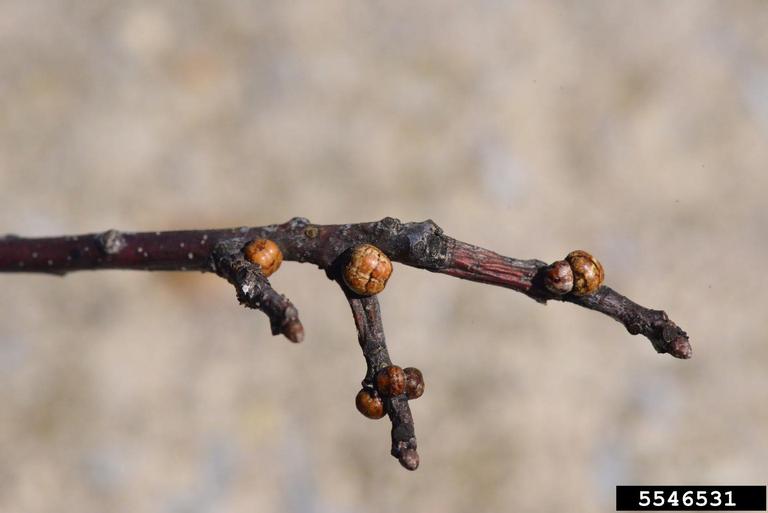 The browning of leaves on the ends of oak branches is a common site at this time of year and a concern for tree owners. This symptom is referred to as flagging and typically shows up from late July into September. In most cases, it is caused by one of four factors.
The browning of leaves on the ends of oak branches is a common site at this time of year and a concern for tree owners. This symptom is referred to as flagging and typically shows up from late July into September. In most cases, it is caused by one of four factors.
Kermes scale appear as round, ¼", marbled brown raised bumps on twigs near branch tips. They are not flat like many scales. Mature kermes are limbless, sucking insects that remain immobile while they feed. As they feed on sap, they secrete a sticky honeydew that may result in the growth of sooty mold as well as leaf flagging and branch dieback.
Natural enemies help keep kermes scale in check. Insecticidal control is difficult due to tree size, coverage and timing. Insecticides need to be applied during the crawler stage, right after egg hatch, which varies on what type of oak tree is infested. Kermes scale crawlers on red oak, pin oak and black oak are active in September. On white oaks, like bur oak, they are active in April and June. Active ingredients effective against kermes include bifenthrin, flupyradifurone, horticultural oil (Paraffinic or superior oil), permethrin, and pyriproxyfen. Using a horticultural oil (organic option) will control crawlers and help conserve natural enemies. Soil applied systemic insecticides, i.e. imidacloprid, can be applied in fall for spring control of bur oak scales. Image right - David L. Clement, University of Maryland, Bugwood.org.
A Bug's Life: Kermes Scale, Nebraska Extension
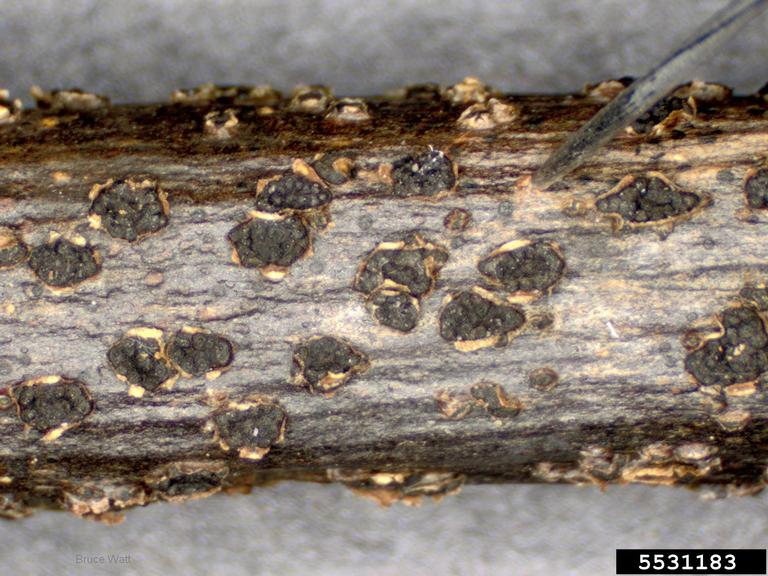 Botryosphaeria cankers are caused by fungal infection of branches through small wounds, natural openings like lenticels, and new succulent growth. These cankers are caused by a group of pathogens that are similar to one another in that they overwinter in infected branches and twigs and begin releasing spores in spring which can cause new infections. Small wounds from insect feeding, hail, pruning, or other factors increase the risk of infection. Botryosphaeria can attack a very wide range of woody plants. Cankers cut off transport of water and nutrients in infected branches, resulting in branch dieback or flagging.
Botryosphaeria cankers are caused by fungal infection of branches through small wounds, natural openings like lenticels, and new succulent growth. These cankers are caused by a group of pathogens that are similar to one another in that they overwinter in infected branches and twigs and begin releasing spores in spring which can cause new infections. Small wounds from insect feeding, hail, pruning, or other factors increase the risk of infection. Botryosphaeria can attack a very wide range of woody plants. Cankers cut off transport of water and nutrients in infected branches, resulting in branch dieback or flagging.
Fungicides are not effective against canker diseases. Infected branches should be pruned out 8" below the cankered area or ideally back to where the branch attaches to another branch or the trunk. Image right - fungal fruiting structures of Botryosphaeria canker emerging through the bark, Bruce Watt, University of Maine, Bugwood.org.
NOTE: Purdue University has found a possible connection between Kermes scale and Botryosphaeria. After noticing it was common to see both on a branch, they conducted a small survey of trees on the Purdue campus. They found that all 10 twigs collected had both Kermes scale and cankers, indicating an association between the two. If so, controlling Kermes scale might help reduce these types of cankers.
Oak Kermes Scale and Fungal Dieback: A One-Two Punch for Northern Red Oak, Purdue University
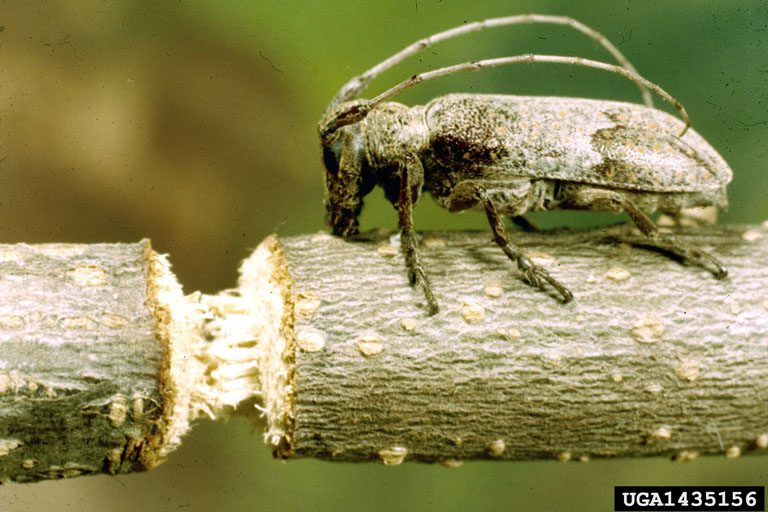 Oak twig girdler is a longhorn beetle that emerges in late summer. In eastern Nebraska, the most common twig girdler is Oncideres cingulata. This group of insects are known as longhorn beetles due to the length of the adult insects' antennae. They have one generation per year, and at maturity are grayish-brown, stout-bodied beetles, about 3/4" long. Adults appear in late summer from mid-August through early October. Image left - adult oak twig girdler, Clemson University, USDA Cooperative Extension Slide Series, Bugwood.org. Image below - clipped twigs, Gerald J. Lenhard, Louisiana State University, Bugwood.org.
Oak twig girdler is a longhorn beetle that emerges in late summer. In eastern Nebraska, the most common twig girdler is Oncideres cingulata. This group of insects are known as longhorn beetles due to the length of the adult insects' antennae. They have one generation per year, and at maturity are grayish-brown, stout-bodied beetles, about 3/4" long. Adults appear in late summer from mid-August through early October. Image left - adult oak twig girdler, Clemson University, USDA Cooperative Extension Slide Series, Bugwood.org. Image below - clipped twigs, Gerald J. Lenhard, Louisiana State University, Bugwood.org.
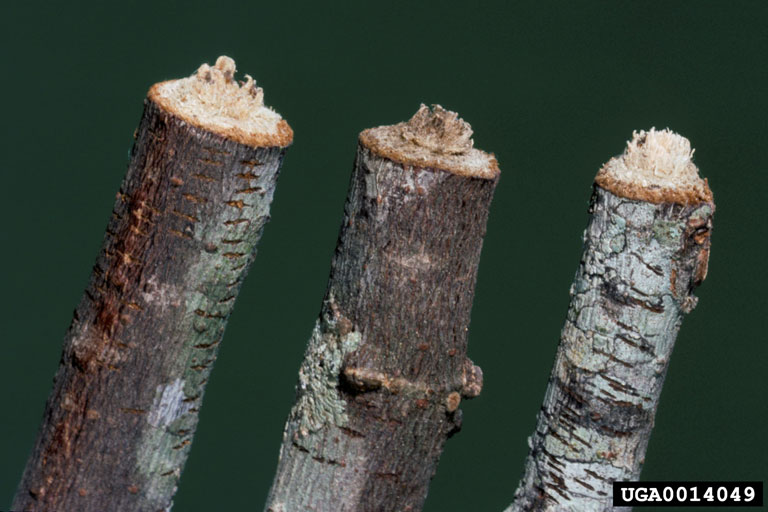 The female beetle prepares to lay eggs by chewing through the bark of a small twig in a grooved channel that goes all the way around the twig, girdling it. She lays an egg in the girdled twig section, which quickly wilts, turns brown and dies. Larvae, which are creamy white, grub-like borers, cannot survive in healthy wood, but do fine in the dead twig even after it falls from the tree. When twigs fall from the tree, a close inspection of the twig's cut end looks a lot like beaver damage, in miniature. While damage is obvious, it is rarely severe, and there is usually no need for control. Larvae overwinter inside twigs. Homeowners can pick up and discard dead twigs that fall to the ground to reduce this insect.
The female beetle prepares to lay eggs by chewing through the bark of a small twig in a grooved channel that goes all the way around the twig, girdling it. She lays an egg in the girdled twig section, which quickly wilts, turns brown and dies. Larvae, which are creamy white, grub-like borers, cannot survive in healthy wood, but do fine in the dead twig even after it falls from the tree. When twigs fall from the tree, a close inspection of the twig's cut end looks a lot like beaver damage, in miniature. While damage is obvious, it is rarely severe, and there is usually no need for control. Larvae overwinter inside twigs. Homeowners can pick up and discard dead twigs that fall to the ground to reduce this insect.
Twig Girdler, K-State Research and Extension
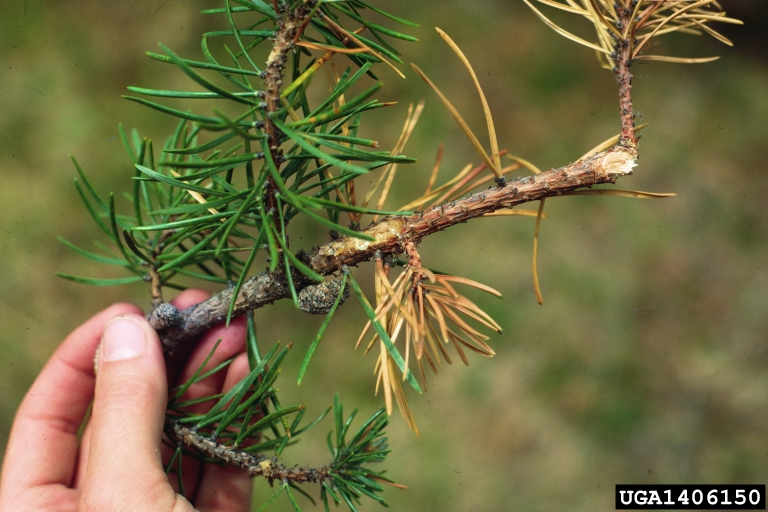 Squirrels clipping tree twigs can be confused with girdler damage. Squirrels clip off twigs from trees most often in spring and in early fall. One reason, during fall, is to collect acorns attached to the twigs after the branch falls to the ground. Fortunately, most of this damage does little permanent harm to established trees and is more of a nuisance to the homeowner cleaning up the twigs. Image left - twigs clipped by squirrels are cleanly cut at an angle, USDA Forest Service - North Central Research Station, Bugwood.org.
Squirrels clipping tree twigs can be confused with girdler damage. Squirrels clip off twigs from trees most often in spring and in early fall. One reason, during fall, is to collect acorns attached to the twigs after the branch falls to the ground. Fortunately, most of this damage does little permanent harm to established trees and is more of a nuisance to the homeowner cleaning up the twigs. Image left - twigs clipped by squirrels are cleanly cut at an angle, USDA Forest Service - North Central Research Station, Bugwood.org.
2. September 4th growing degree day(GDD)
| Location | Accumulated Growing Degree Days |
|---|---|
| Grand Island, NE - Airport | 3146 |
| Lincoln, NE - Airport | 3271 |
| Omaha, NE - Airport | 3223 |
| Norfolk, NE - Airport | 3025 |
| North Platte, NE - Airport | 2699 |
| Scottsbluff, NE - Airport | 2570 |
3. Pest updateFinal 2023 pest list; Growing Degree Days (GDD) control timing
The insect control season is drawing to an end. Below are the final serious insects of concern and their control periods, in case any late season control was missed or rescue treatments needed. But most parts of the state are past the prime control periods now. New GGD calculations for 2024 will begin in January.
| GGD (base 50) | Insect | Lifestage present at this GGD |
|---|---|---|
| 950-2150 | Japanese beetle | Adult emergence |
| 1000-2000 | Emerald ash borer | Peak adult emergence |
| 1700-2100 | Arborvitae leafminer | 3rd generation |
| 1800-2200 | Banded ash clearwing | adult emergence |
| 1850-2025 | Fall webworm | Tents become apparent |
| 1900-2050 | Euonymus scale | 2nd generation egg hatch |
| 1925-1950 | Magnolia scale | Egg hatch |
For a more complete list, visit Michigan State University GGD of Landscape Insects or GGD of Conifer Insects.
4. Consequences of late summer/early fall pruningPruning now stimulates new growth; increases potential for cold damage to new growth
Pruning is an invigorating process which stimulates new growth. Whenever pruning is done during the growing season, new growth will quickly follow. Late summer/early fall pruning of evergreens, such as yew or boxwood, and spring or summer-flowering shrubs leads to the development of new growth. It takes time for this new growth to harden off and develop full cold hardiness, making the new growth very prone to damage from freezing temperatures in October/November or winter injury. If pruning needs to be done before winter, wait until plants are dormant. The EXCEPTION to this rule is removal of dead, diseased or damaged branches; this can be done at any time. Image right - winter burn of yew growth not hardened off properly by winter due to late season pruning.
Ideal pruning times:
- spring flowering trees & shrubs - immediately after flowering
- summer flowering trees & shrubs - late winter or early spring
- oaks - dormant season pruning is recommended, no pruning from April through June
- most shade and non-blooming ornamental trees -during dormancy, just before growth begins in spring, February to early April
- fruit trees - January through March; start with most cold hardy first and prune the least cold hardy just before new growth begins. Most cold hardy - apple, pear, tart cherry, plum; least cold hardy - sweet cherry, peach, apricot
- evergreen trees (spruce, fir) - late winter while still dormant, February through early April
- pines - during candle stage, late May to early June
- evergreen shrubs (juniper, yew, boxwood) - before new growth begins, late March to early April; light pruning in late June or early July if needed
5. White grub rescue treatmentsMay be needed if damage is extensive, grub numbers are greater than 5-8 per square foot and early season insecticide was not applied
If grub damage is extensive in August or September, with five or more white grubs per square foot, a rescue application of either carbaryl (Sevin) or trichlorfon (Dylox) can be applied. It must be watered in for acceptable control. Moving the insecticide into the root zone requires applying one-half inch of water immediately after application.
Managing White Grubs in Turfgrass, Purdue University
6. Spruce spider miteWatch for damage from fall generation in late September into October
Spruce spider mite becomes active again in fall when temperatures drop consistently below 80° F. Stippling damaging of needles occurs, infested portions turn yellow or brown and appear dried out. Dirty, fine webbing is evident. Occasionally heavily infested trees suffer severe damage.
Treat infestations with vigorous sprays of an insecticidal soap or an insecticide/miticide. Thorough coverage is important, and re-treatment is often necessary.
Spruce Spider Mite, Penn State University Extension
7. Fall season's tiny bitersNuisance insects: lace bugs and minute pirate bugs
Working outdoors brings with it several potential insects which can cause uncomfortable itchy bites. The most common culprits include mosquitoes, chiggers and biting flies. Below are two additional insects occasionally causing problems, especially in late summer.
Lace Bugs
There are many species of lace bugs, all so named because of the delicate lacy wings adults hold flat over their back and not to be confused with lacewings. Adult insects are small, only about 3/16 inches long. Birch, hackberry, hawthorn, elm, oak, sycamore and walnut lace bugs are common species, each attracted by specific host trees. They are all plant-feeding insects, usually found on the undersides of leaves.
Each species has 2-3 generations per year, overwintering as adults in protected locations near their preferred tree. Small groups of eggs are inserted into leaf veins in spring, followed by several nymphal stages as the insects develop.
Both adults and nymphs have a piercing-sucking, straw-like mouth used to suck juices from leaves. In fall, adults and/or the even smaller nymphs can fall out of trees and land on your skin. Immature nymphs, which are black, may look like a tiny black speck of pepper. As their mouth pierces skin, you may feel a tiny prick. These insects don't feel on people or blood, they are strictly a nuisance pest.
Lace Bugs, The Ohio State University
Minute Pirate Bugs
These tiny bugs, 1/8-inch long, can cause painful bites that seem out of proportion with their size. They are oval to triangular in shape, flattened and black with whitish markings on the back. Normally, they are predators and feed on insect eggs and small insects. They feed by impaling their prey with their short blunt beak and sucking the juices.
Minute pirate bugs are found throughout the summer in fields, woodlands, gardens and landscapes. In the late summer, they begin the unpleasant behavior of biting humans. They do not feed on blood or inject a venom or saliva.
People differ in their response to pirate bug bites. Some people have no reaction to the bite, but others have bites that swell like a mosquito bite or turn red. Because the bite is noticeable and the pirate bug doesn't fly quickly, the victim is usually able to successfully smash the offending insect.
Preventing lace bugs and minute pirate bugs from biting you is not easy. Repellents are generally not effective, although some people have found applying baby oil or suntan oil liberally to the skin may prevent some bites by coating the bugs with oil.
Minute Pirate Bugs: Little Bugs, Big Bite, Nebraska Extension
What's Biting You?, Nebraska Extension
8. Nuisance home invadersInsects, spiders, mice - exclusion provides best control
These pests may enter homes in fall as temperatures cool and they begin to look for overwintering sites. Pests like boxelder bugs, millipedes and Asian lady beetles are common. Most are harmless but still a nuisance.
Exclusion is the best means of reducing nuisance pests and mice indoors. Caulk cracks, crevices and conduits of the home. Repair window screens and check that doors are tight fitting. If needed, insecticides can be applied to building foundations according to label direction. Ideally, apply the insecticide from the foundation out to five to 10 feet.
Insects That Overwinter in Your Home, Nebraska Extension
Keeping Occasional Invaders Out, Nebraska Extension
Boxelder Bugs, Nebraska Extension
Controlling House Mice, Nebraska Extension
Identification Guide to Common Spiders in Nebraska, Nebraska Extension
Millipedes, Nebraska Extension
Multi-colored Asian Ladybird Beetles, Nebraska Extension
9. Fall garden clean upFruits, vegetables and landscape plants; fall garden sanitation helps control pests and diseases
Many disease organisms carry over from one season to the next on infected branches, leaves or fruits. Diseased leaves fall to the ground beneath the infected plant and, if they are not removed and discarded, will produce new fungal spores or bacteria to reinfect the plant the following growing season. Removing infected plant debris reduces the disease pressure the following season. Keep this control method in mind for common shade tree foliage infections, including Anthracnose, powdery mildew, apple scab, Septoria and many other leaf spot pathogens. Black spot of rose is another very common fungal pathogen.
In a similar manner, fruit tree disease problems often overwinter on fruit "mummies"; dried infected fruits that may remain in the tree or fall to the ground beneath the tree. If mummies are still in the tree or beneath it, they serve as an infection source the following year.
Diseases also remain active from year to year through infected twigs, branches or cankers. Fireblight is one of the most serious fruit and ornamental diseases which overwinters on infected woody tissue. Fireblight is a bacterial disease which infects and kills twigs and branches, most commonly during spring and early summer. However, it can also infect the mature bark of older branches or tree trunks; this infected bark is called a canker and often serves as a source of additional spores or bacteria, allowing the disease to progress throughout the plant during a growing season or reinfect it’s foliage or new branches in future years. Unfortunately, there are many other disease pathogens that can infect woody branches or bark and cause cankers, such as brown rot of peach, apricot, plum and cherry.
Many insects overwinter on plants they attacked the previous summer or nearby plant debris, such as iris borer (overwinter as eggs on iris leaves or nearby plants) or common stalk borers (overwinter as eggs on nearby grass stems or weeds). Cucumber beetles overwinter as adults in plant debris and other protected areas. Common fruit insects – plum curculio overwinters as adults in plant debris, cherry fruit fly inside fallen fruits.
Sanitation Steps
As you can see, sanitation is very important for reducing disease and insect pressure in your garden or landscape each year. Important steps include the following.
- Rake up and discard or burn all debris beneath infected plants each fall, including leaves and fruit. This includes infected trees, shrubs and ornamentals such as peonies. In the vegetable garden, remove disease infected plants like tomatoes or peppers and rake up as much old foliage as possible along with all discarded fruits.
- Inspect woody plants for cankers and dead stems. Prune out and destroy all dead or diseased branches and twigs each spring. If you suspect the branches were killed by a disease, cuts should be made at least 4-6 inches below the margin of visible infection. Ideally, fruit tree pruning should be done in spring just before new growth starts.
- If your tree is susceptible to fireblight or has a history of infections, be sure to clean the pruners between each cut. Clean pruners by dipping them in a 10% bleach solution (9 parts water to 1 part bleach) between cuts. With a known fireblight infection, make cuts 8-12 inches below the margin of visible infection. Dry and oil tools after use to prevent rust.
- In Iris plantings, remove old dead foliage before April 1.
- Black spot of rose can be reduced by removing all infected leaves and mulch beneath plants in fall. Prune out canes with dark colored lesions, then reapply a fresh layer of new mulch.
- Do not compost this material. Most home compost piles do not get hot enough to kill all pathogens
Herbaceous perennials - If and when to cut plants back in fall is a commonly asked question. Perennials eventually need to be cut back as their stems and leaves do not live from year to year and the dead tops needs to be removed. Wait until the foliage is killed by frost to cut back perennials. After that, whether to cut plants back in late fall or spring is up the homeowner and may depend on the ecosystem value and/or winter interest of the plant. Plants with hollow stems provide nesting sites for solitary bees which are important pollinators.
Seeds of some dried flowers, like Rudbeckia, are a food source for birds. The plumes of ornamental grasses provide winter interest as do the spent flower cones of plants like Rudbeckia and coneflowers. Note that tall ornamental grasses can be a fire hazard, especially if grown next to a house and left over winter.
10. ProHort Lawn & Landscape Update- Lunch & LearnFinal conversation - September 22
Lunch and Learn zooms are something new. It is an informal opportunity for Extension staff and greenspace professionals to share what’s happening in landscapes, management recommendations and helpful resources. Mark your calendars for this year's final program - September 22, 12:00 pm to 1:00 pm. Please join us. Be ready to share! Program is free and open to all green industry professionals. Register now to receive the free zoom link.
14. Commercial/Non-commercial pesticide applicatorsObtaining a new license or updating an expired license
If you have a pesticide applicators license which expired in April 2023 or you need to get a new license, testing options are listed below.
Testing-only Options
- Closed-book exams are given by the Nebraska Department of Agriculture (NDA). Preregistration is not required an there is no cost. Visit the link below for a list of available test-only dates, times and locations - https://pested.unl.edu/.
- NDA computer-based testing is provided through the Pearson-Vue company. Click here for a list of testing sites, categories available, dates, and registration information. Cost $55 per exam. (For applicators with multiple categories on their license, each category is charged the full testing fee.)
Commercial/noncommercial applicators are professionals who apply restricted-use pesticides for hire or compensation. Anyone who applies pesticides to the property of another person, either restricted- or general-use products, for control of pests in lawns, landscapes, buildings or homes must also have a commercial pesticide applicators license. Public employees (those employed by a town, county, state) applying mosquito control pesticides whether restricted- or general-use, must also hold a commercial or noncommercial certification.
15. Digital Diagnostic Network - Need help with diagnostics?Submit pictures and questions for diagnosis by Nebraska Extension experts
Do you or your clients have questions you need help answering? Maybe you are a lawn care person and they're asking about trees, shrubs, or flowers? While you can refer them to their local Extension office, another option is Digital Diagnostic Network. Homeowners, lawn care professionals, pest control operators and others are invited to submit questions and photos through this website or with the assistance from an Extension professional at any Nebraska Extension office. All offices are equipped with high-resolution digital image capturing technology. Whether the question is about a lawn weed, insects on a plant, diseases in a shrub border or other, an expert panel of Extension professionals will review and respond to the question. To get started, create an account so the question can be reviewed and responded to via email. For more information and to create an account, go to Digital Diagnostic Network.
Bugging Out With Your Camera Phone - Tips on how to get a good picture.
Reference to commercial products or trade names is made with the understanding that no discrimination is intended and no endorsement by Nebraska Extension is implied. Use of commercial and trade names does not imply approval or constitue endorsement by Nebraskas Extension. Nor does it imply discrimination against other similar products.

